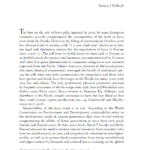A summary of: Kava as a Clinical Nutrient: Promises and Challenges.

Bian, Tengfei, Pedro Corral, Yuzhi Wang, Jordy Botello, Rick Kingston, Tyler Daniels, Ramzi G. Salloum, et al. 2020. “Kava as a Clinical Nutrient: Promises and Challenges.” Nutrients 12 (10). https://doi.org/10.3390/nu12103044.
Fast Summary:
- The document explores the clinical applications of kava, a beverage prepared from the root of Piper methysticum. It has been consumed among Pacific Islanders for centuries and has been used to treat anxiety in Europe. The paper discusses kava’s anti-inflammatory, anticancer effects, and neurological benefits, along with challenges related to hepatotoxicity and the lack of standardization in kava products.
Full Summary:
Introduction
Derived from the root of Piper methysticum, kava has been a staple in the Pacific region for centuries. Its popularity in Western countries has grown, especially as a treatment for anxiety. The document explores the chemical composition of this plant and its increased demand, highlighting the need for better control over consistency and quality.
Benefits
Anti-Inflammatory and Anti-Cancer Effects
Kava’s compounds have shown potential in treating inflammatory diseases. Growing evidence suggests that consumption of this plant could be linked to a low incidence of cancer, particularly in stress and anxiety reduction. Further exploration is needed to understand the mechanisms and responsible ingredients.
Neurological Benefits
Clinically, kava has been used to treat epilepsy and may reduce cravings for substances like alcohol, tobacco, cocaine, and heroin. Addiction rehabilitation programs have reported a 90% success rate using kava. Its effects on memory tasks, visual attention, working memory, and sleep disorders are also noted.
Challenges
Hepatotoxicity
Evidence suggests that the hepatotoxic risk associated with kava is very low. However, factors contributing to this risk need to be addressed.
Lack of Standardization
The absence of rigorous standardization in the cultivation, harvest, and manufacturing of kava has led to contradictory observations and safety concerns.
Historical Background
The document offers insights into the history and various forms of this plant, including traditional preparation and commercial dietary supplement forms.
Current Research
Chemical Composition
The review focuses on the chemical composition of kava and its potential in treating inflammatory diseases.
Therapeutic Potential
Emphasis is placed on the therapeutic potential of this plant in treating conditions like anxiety, inflammation, and cancer.
Safety Concerns
The safety of kava in recent clinical trials is highlighted, along with the very low hepatotoxic risk. Rigorous quality control (QC) is essential for understanding its safety and efficacy.
Quality Control
The review stresses the urgent need for quality control and assurance, addressing challenges in standardization, foundational pharmacology, pharmacokinetics, absorption, distribution, metabolism, excretion (ADME), and more.
Notes
Lack of Standardization
The diversity of products derived from this plant and the absence of standardization present significant challenges.
Therapeutic Potential
The therapeutic potential of kava is emphasized, but more research is needed to fully understand its applications.
Quality Assurance
The importance of quality control and assurance in products derived from this plant is stressed, essential for maximizing clinical efficacy and minimizing risks.
Personal Note
The World Health Organization (WHO) acknowledged kava as non-toxic in 2016, adding credibility to its safety profile. The need for rigorous research and adherence to best practices in preparation and consumption is also emphasized.
Conclusion
The document concludes that designer preparations could be promising clinical herbal modalities. To realize the full potential, challenges must be addressed, including standardization, knowledge gaps, and the need for human clinical trials.
Overall Impression
The paper offers a comprehensive examination of the clinical applications, benefits, challenges, and importance of quality control and standardization of kava. It highlights the potential as a therapeutic agent and the need for continued exploration and research.



